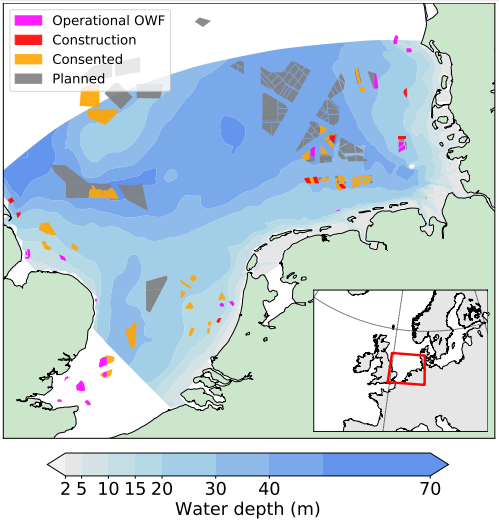First Evidence That Offshore Wind Farms Are Changing the Oceans
Offshore wind farms are becoming increasingly common in our oceans. In Europe, the goal is for them to supply over 4 percent of the continent’s electricity by 2030. And that’s triggering a wind power boom—the amount of electricity they generate is expected to increase 40-fold by 2030.
Offshore wind turbines are huge—much bigger than their land-based counterparts. They can be over 200 meters tall—twice the height of the Big Ben clock tower in London—and generate up to nine megawatts of power. But most of their mass is in the concrete and steel bases that sit underwater.
Naturally, these bases become home to complex ecosystems. In the North Sea, where most of the European farms are being built, these ecosystems are dominated by blue mussels. These feed by filtering phytoplankton from the water. Mussels are also a food source for other marine animals, such as fish and crabs, and this has the potential to significantly alter the food web.

And that raises an important question. How are offshore wind farms, and the new colonies of blue mussels they support, changing the oceans?
Today we get an answer thanks to the work of Kaela Slavik at the Helmholtz Centre for Materials and Coastal Research in Germany and a few pals, who have investigated the impact of offshore wind power on marine ecosystems for the first time. Their conclusions are stark—they say offshore wind platforms are changing the nature of marine ecosystems in complex, unanticipated, and beneficial ways.
The team’s method is straightforward. Their goal is to measure the current changes in the marine ecosystems caused by offshore wind farms and then create a computer model that they can use to predict future changes.
The team starts with measurements of the biomass of blue mussels that a typical wind turbine can support—some four metric tons of the shellfish. Using maps of current and planned windfarms in the North Sea, it’s then straightforward to estimate the total mass and distribution of blue mussels supported by wind farms now and in 2030.
That gives an interesting result. Mussel beds are currently concentrated around the coast, but wind farms are offshore. “Once all the planned wind farms are in operation, they will provide habitat for mussels that are equal to 20 percent of the current stock from natural mussel beds along the coast,” say Slavik and co.
The next steps are harder. An important question is how the new mussel colonies will change phytoplankton levels in the ocean. Slavik and co investigate this using water and satellite measurements. But this is complex data that varies significantly from year to year.
Beyond that, the team studies the simulated effect of blue mussels as “ecosystem engineers”—how they support other species in the North Sea.
Their conclusions make for interesting reading. Slavik and co say one important effect of offshore wind farms is that they act as marine preservation areas, because fishing and bottom trawling is not allowed for safety reasons. So these areas can support greater biodiversity than unprotected areas.
Blue mussels themselves also significantly change this environment. They support other species, since their shells and shell litter are habitats for other creatures. The way blue mussels filter feed makes water clearer, and they concentrate nutrients for other species. This increases “the degree of habitat complexity, encouraging a higher level of species richness,” say the team.
One unanticipated consequence of all this is that these new ecosystems can support alien species which would not otherwise be able to gain a foothold. One example is the marine splash midge, which is native to Australasian waters and transported on the hulls of ships. “It has been observed at offshore wind farms in Denmark and along the Swedish Baltic coast,” say Slavik and co.
But the long-term consequences of this change in biodiversity is unknown. “Through these changes in biodiversity, offshore wind farms could shape the marine ecosystem beyond their physical boundaries,” say the researchers.
Mussels are also food for larger species such as crabs and certain fish, which are themselves prey for seals. So it’s no surprise that seals have already begun to migrate to off shore wind farms off the coast of Denmark.
For the most part, Slavik and co are cautiously positive about the changes that offshore wind farms cause, but they are quick to point out that the longer-term effects are still unknown. “Many of the ecosystem feedbacks and hence changes to ecosystem services are yet unknown and need to be studied both in situ and in future system-wide synoptic studies,” they say.
So more work is obviously needed, particularly in other areas where offshore wind farms are planned. The ecosystems that the North Sea support are obviously different from those in other oceans. Just how the platforms will change ecosystems in other parts of the world isn’t clear.
But this study shows for the first time that offshore wind farms are changing our oceans. Clearly, we need to know more about how this will happen.
Ref: arxiv.org/abs/1709.02386: The Large Scale Impact of Offshore Windfarm Structures on Pelagic Primary Production in the Southern North Sea
Deep Dive
Climate change and energy
The problem with plug-in hybrids? Their drivers.
Plug-in hybrids are often sold as a transition to EVs, but new data from Europe shows we’re still underestimating the emissions they produce.
Harvard has halted its long-planned atmospheric geoengineering experiment
The decision follows years of controversy and the departure of one of the program’s key researchers.
Why hydrogen is losing the race to power cleaner cars
Batteries are dominating zero-emissions vehicles, and the fuel has better uses elsewhere.
Decarbonizing production of energy is a quick win
Clean technologies, including carbon management platforms, enable the global energy industry to play a crucial role in the transition to net zero.
Stay connected
Get the latest updates from
MIT Technology Review
Discover special offers, top stories, upcoming events, and more.